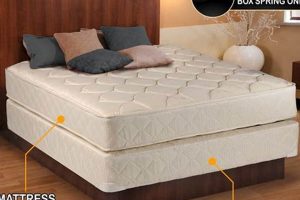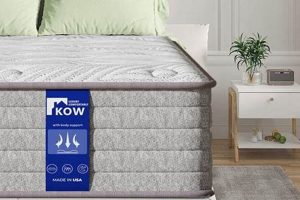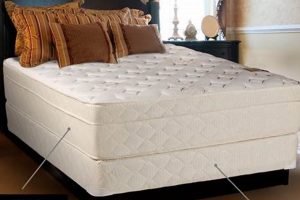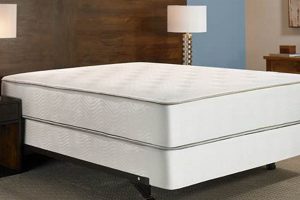A supportive base is crucial for a memory foam mattress to function optimally and maintain its longevity. The necessity of a traditional box spring, however, is not always guaranteed. Considerations should be made regarding the existing bed frame and the type of support it offers.
Proper support enhances the comfort and lifespan of the sleep surface. Adequate elevation facilitates air circulation, mitigating potential moisture buildup. Historically, box springs were designed to absorb shock and distribute weight, contributing to the overall durability of innerspring mattresses.
The suitability of a particular support system hinges on factors such as the mattress manufacturer’s recommendations, warranty requirements, and individual preferences regarding bed height and overall support characteristics. Platform beds, slatted foundations, or adjustable bases may serve as suitable alternatives. Careful evaluation is essential to ensure compatibility and maximize the benefits of the memory foam mattress.
Guidance on Memory Foam Mattress Support
Selecting the appropriate foundation for a memory foam mattress impacts support, comfort, and longevity. The following guidance aids in determining the optimal support system.
Tip 1: Consult Manufacturer Specifications: Review the mattress manufacturer’s guidelines. These often specify the recommended base type to ensure warranty validity and optimal performance.
Tip 2: Assess Existing Bed Frame: Evaluate the existing bed frame’s construction. Frames with closely spaced slats or a solid platform may provide adequate support, negating the requirement for a traditional box spring.
Tip 3: Consider Support Type: Memory foam mattresses require firm, even support. Avoid foundations with sagging or uneven surfaces, as these can compromise mattress integrity and comfort.
Tip 4: Evaluate Bed Height: Determine the desired bed height. A box spring adds height, which may be undesirable if the bed frame is already elevated. Platform or adjustable bases offer alternative height options.
Tip 5: Ensure Adequate Ventilation: Adequate airflow is essential to prevent moisture buildup within the mattress. Slatted foundations or breathable mattress covers can promote ventilation.
Tip 6: Factor in Weight Distribution: Consider the combined weight of the mattress and sleepers. A robust foundation is necessary to withstand the weight and prevent premature sagging.
Tip 7: Prioritize a Solid Foundation: The foundational aspect is one of, if not the most, crucial points when deciding on if a support such as a box spring is needed. Having a solid and strong foundation can save a lot of trouble and money in the long run.
Adhering to these guidelines will help ensure the memory foam mattress receives the support necessary to provide optimal comfort and long-term durability.
Following the provided guidance ensures informed decisions regarding mattress support. Further research into specific foundation types and materials is recommended for tailored solutions.
1. Warranty Requirements
Warranty requirements are a critical factor in determining if a box spring is necessary for a memory foam mattress. Mattress warranties often stipulate specific support structures to maintain validity, directly impacting consumer choice.
- Foundation Type Specification
Mattress warranties frequently delineate acceptable foundation types, such as platform beds, slatted bases with specific spacing, or traditional box springs. Deviation from these specifications may invalidate the warranty. For example, a warranty might require slats to be no more than 2 inches apart to provide adequate support, thus preventing sagging and premature wear.
- Support System Condition
The condition of the support system is often a warranty prerequisite. The foundation must be structurally sound and free from defects, such as broken slats or a sagging frame. A compromised support system can lead to uneven weight distribution, potentially damaging the mattress and voiding the warranty.
- Load Capacity Considerations
Warranties may specify weight limits for the mattress and its support system. Exceeding the specified weight capacity can strain the mattress and foundation, leading to structural failure and warranty invalidation. This is particularly relevant for heavier individuals or couples.
- Consequences of Non-Compliance
Failure to adhere to the warranty’s foundation requirements can result in claim denial should the mattress develop defects. Manufacturers reserve the right to inspect the support system and reject claims if it does not meet the stated criteria. This underscores the importance of carefully reviewing warranty terms prior to purchasing a memory foam mattress.
Compliance with warranty foundation requirements is essential to protect the investment in a memory foam mattress. Adherence to stipulated support conditions ensures that the mattress performs as intended and that warranty coverage remains valid throughout the specified period.
2. Foundation Type
Foundation type significantly dictates whether a box spring is necessary for a memory foam mattress. The purpose of a foundation is to provide stable and even support, essential for preventing mattress sagging and ensuring proper spinal alignment. A traditional box spring, designed with coils to absorb shock, may not be the optimal choice for memory foam, which already possesses inherent shock-absorbing qualities. A platform bed, for instance, offers a solid, flat surface, often eliminating the need for additional support. Conversely, a bed frame with widely spaced slats may necessitate a box spring or bunkie board to prevent the mattress from sinking between the gaps.
Consider a scenario where a memory foam mattress is placed directly on a metal bed frame with slats spaced more than a few inches apart. Over time, the mattress could develop indentations corresponding to the gaps between the slats, leading to discomfort and reduced lifespan. In contrast, a memory foam mattress on a solid platform base would distribute weight evenly, preserving the mattress’s structural integrity. Similarly, adjustable bases, gaining popularity for their customizable support, often preclude the need for a box spring due to their inherent adjustability and support structure.
In summary, the appropriateness of a box spring hinges on the existing support offered by the bed frame. Solid or closely slatted platforms typically render box springs redundant. Frames with insufficient support require either a box spring or an alternative solid support structure to maintain the memory foam mattress’s integrity and ensure proper ergonomic support. Evaluating the foundation type is thus paramount in determining the necessity of a box spring. Failure to do so can impact comfort, mattress longevity, and warranty compliance.
3. Mattress Height
Mattress height influences the perceived need for a box spring with a memory foam mattress. The combined height of the mattress and foundation impacts accessibility and aesthetics. A thicker mattress may elevate the sleep surface to a comfortable height without a box spring, while a thinner mattress might require additional elevation for ease of entry and exit. Individual preferences and physical capabilities are key determinants in this consideration.
For example, a 14-inch memory foam mattress placed on a platform bed might result in a total bed height considered ideal for many adults, obviating the need for a box spring. Conversely, an 8-inch memory foam mattress on the same platform might be too low, prompting the addition of a box spring for increased height. Furthermore, individuals with mobility limitations may benefit from a higher bed, facilitating easier transfers. The decision, therefore, balances ergonomic needs with aesthetic considerations.
In summary, mattress height directly affects the necessity of a box spring. Thicker mattresses may achieve optimal bed height without additional support, while thinner mattresses often require it. Individual preferences and mobility constraints further shape the decision, highlighting the importance of assessing mattress height in conjunction with personal needs when evaluating support options.
4. Support Structure
The support structure underlying a memory foam mattress directly influences its performance and longevity, impacting the necessity of a box spring. The existing framework’s ability to provide consistent and even support is the determining factor.
- Slatted Foundations
Slatted foundations consist of wooden or metal slats spanning the width of the bed frame. The spacing between slats is crucial; wide gaps may cause the mattress to sag, compromising support and potentially voiding the warranty. Closely spaced slats offer more uniform support, often negating the requirement for a box spring if the mattress manufacturer approves this configuration.
- Platform Beds
Platform beds provide a solid, continuous surface for the mattress. This eliminates the need for a box spring, as the platform itself provides ample support and prevents sagging. The absence of gaps ensures even weight distribution, maximizing the mattress’s lifespan. However, it’s important to verify the platform’s weight capacity to ensure it can adequately support the mattress and occupants.
- Adjustable Bases
Adjustable bases offer customizable support and positioning. These bases typically feature a rigid frame with adjustable sections, eliminating the need for a box spring. The inherent adjustability allows for personalized comfort and support, catering to individual preferences and medical needs. Integrating a memory foam mattress with an adjustable base can enhance sleep quality and alleviate certain physical discomforts.
- Existing Box Spring Condition
If an existing box spring is present, its condition must be assessed. A sagging, damaged, or worn-out box spring will compromise the support of the memory foam mattress, potentially leading to premature wear and reduced comfort. In such cases, replacing the box spring or opting for an alternative support structure, such as a platform bed, is advisable to ensure optimal mattress performance.
The suitability of a given support structure significantly determines whether a box spring is necessary. Solid platforms and adjustable bases typically render box springs redundant, while slatted foundations require careful evaluation of slat spacing. Assessing the existing support structure’s condition is paramount to ensuring adequate support and maximizing the lifespan of the memory foam mattress. The ultimate decision hinges on providing a stable, even surface that promotes proper spinal alignment and prevents premature wear.
5. Ventilation
Ventilation plays a critical role in maintaining the integrity and hygiene of a memory foam mattress, influencing the necessity of a box spring or alternative support system. Proper airflow mitigates moisture accumulation, which can lead to mold growth and material degradation.
- Moisture Management
Memory foam’s dense structure can trap moisture from perspiration and environmental humidity. Inadequate ventilation exacerbates this issue, creating a breeding ground for bacteria and mold. A box spring or slatted foundation elevates the mattress, promoting air circulation beneath and reducing moisture buildup. Conversely, a solid platform bed without adequate ventilation features may require additional measures like breathable mattress covers to manage moisture.
- Temperature Regulation
Poor ventilation can lead to increased heat retention within the mattress. Memory foam’s insulating properties can cause sleepers to overheat, particularly in warmer climates. A ventilated foundation, such as a box spring or slatted base, facilitates heat dissipation, contributing to a more comfortable sleep environment. Solid platforms, however, may impede airflow, potentially exacerbating heat retention issues.
- Material Integrity
Prolonged exposure to moisture can compromise the structural integrity of memory foam. Mold and mildew growth can degrade the foam, leading to premature sagging and reduced lifespan. A ventilated foundation helps prevent moisture accumulation, preserving the mattress’s resilience and extending its usable life. Without adequate ventilation, the mattress is more susceptible to damage and deterioration.
- Hygiene and Allergen Control
Poor ventilation promotes the proliferation of dust mites and allergens within the mattress. These microscopic organisms thrive in humid environments, exacerbating allergy symptoms and respiratory issues. A ventilated foundation reduces moisture, inhibiting dust mite growth and improving overall hygiene. Regular cleaning and the use of hypoallergenic mattress covers further enhance allergen control, particularly when using a solid platform without built-in ventilation.
The necessity of a box spring, or an alternative support system, is therefore intrinsically linked to ventilation requirements. Adequate airflow is essential for maintaining a hygienic and durable sleep surface. Where the chosen foundation impedes ventilation, supplementary measures become necessary to mitigate moisture buildup and ensure a healthy sleep environment, thereby impacting the overall suitability of the support system.
Frequently Asked Questions
This section addresses common inquiries regarding the compatibility of memory foam mattresses with various support systems.
Question 1: Does every memory foam mattress necessitate a box spring?
The need for a box spring is contingent on the existing bed frame and the mattress manufacturer’s guidelines. A solid platform or closely slatted base may suffice, while frames lacking adequate support require a supplementary foundation.
Question 2: What occurs if a memory foam mattress is placed directly on the floor?
Placing a memory foam mattress directly on the floor can impede ventilation, leading to moisture accumulation and potential mold growth. This practice may also void the manufacturer’s warranty.
Question 3: Can an old box spring be used with a new memory foam mattress?
The suitability of an existing box spring depends on its condition. A sagging or damaged box spring will compromise support and reduce the lifespan of the memory foam mattress, necessitating replacement.
Question 4: How does a platform bed compare to a box spring for memory foam mattresses?
Platform beds provide a solid, even surface, eliminating the need for a box spring. This offers stable support and prevents sagging, contributing to the mattress’s longevity.
Question 5: Will using the wrong foundation void the memory foam mattress warranty?
Non-compliance with the manufacturer’s specified foundation requirements can void the mattress warranty. Review warranty terms carefully to ensure adherence to stipulated support conditions.
Question 6: What is the optimal slat spacing for a slatted bed frame supporting a memory foam mattress?
Slat spacing should not exceed a few inches to provide adequate support. Wider gaps may cause the mattress to sag between the slats, compromising comfort and potentially damaging the mattress.
Proper support is crucial for optimizing the performance and longevity of a memory foam mattress. Understanding the various support options and their implications is essential for making informed decisions.
The following section explores the potential impact of different support systems on the overall sleep experience.
Determining Mattress Foundation Requirements
The question of whether one requires a box spring with a memory foam mattress is not universally answered. The necessity is contingent upon a convergence of factors, including the existing bed frame, the mattress manufacturer’s specifications, and individual preferences concerning bed height and support. A thorough assessment of these elements is paramount.
Ultimately, the informed decision safeguards the mattress investment and contributes to optimized sleep quality. Prioritizing compatibility between mattress and foundation ensures long-term comfort and adherence to warranty stipulations, underscoring the importance of diligent evaluation.


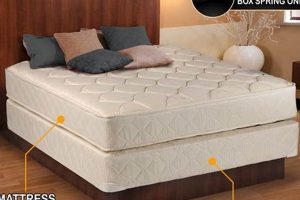
![Best Mattress Firm Box Springs [Guide & Review] Organic & Natural Mattress Buyer’s Guide: Non-Toxic Sleep Solutions Best Mattress Firm Box Springs [Guide & Review] | Organic & Natural Mattress Buyer’s Guide: Non-Toxic Sleep Solutions](https://mattressworldpa.com/wp-content/uploads/2025/07/th-3388-300x200.jpg)
